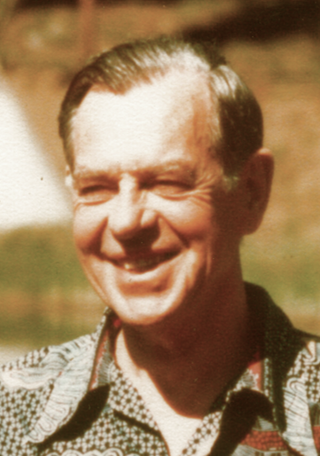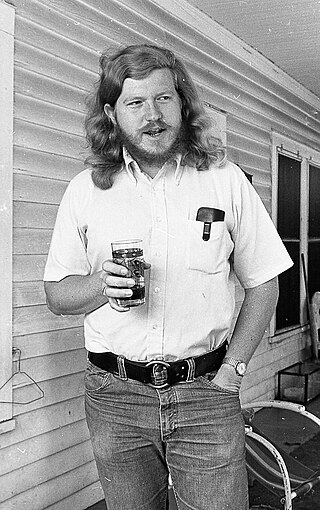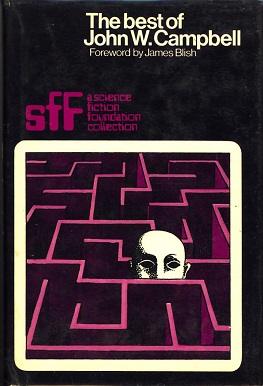
Dorothy Parker was an American poet and writer of fiction, plays and screenplays based in New York; she was known for her caustic wisecracks, and eye for 20th-century urban foibles.

Joseph John Campbell was an American writer. He was a professor of literature at Sarah Lawrence College who worked in comparative mythology and comparative religion. His work covers many aspects of the human experience. Campbell's best-known work is his book The Hero with a Thousand Faces (1949), in which he discusses his theory of the journey of the archetypal hero shared by world mythologies, termed the monomyth.

John Wood Campbell Jr. was an American science fiction writer and editor. He was editor of Astounding Science Fiction from late 1937 until his death and was part of the Golden Age of Science Fiction. Campbell wrote super-science space opera under his own name and stories under his primary pseudonym, Don A. Stuart. Campbell also used the pen names Karl Van Kampen and Arthur McCann. His novella Who Goes There? was adapted as the films The Thing from Another World (1951), The Thing (1982), and The Thing (2011).

Theodore Sturgeon was an American fiction author of primarily fantasy, science fiction, and horror, as well as a critic. He wrote approximately 400 reviews and more than 120 short stories, 11 novels, and several scripts for Star Trek: The Original Series.
The Galactic Empire series is a science fiction sequence of three of Isaac Asimov's earliest novels, and extended by one short story. They are connected by their early place in his published works and chronological placement within his overarching Foundation universe, set around the rise of Asimov's Galactic Empire, between the Robot and Foundation series to which they were linked in Asimov's later novels.

Ramsey Campbell is an English horror fiction writer, editor and critic who has been writing for well over fifty years. He is the author of over 30 novels and hundreds of short stories, many of them winners of literary awards. Three of his novels have been adapted into films.
Arkham House was an American publishing house specializing in weird fiction. It was founded in Sauk City, Wisconsin, in 1939 by August Derleth and Donald Wandrei to publish hardcover collections of H. P. Lovecraft's best works, which had previously been published only in pulp magazines. The company's name is derived from Lovecraft's fictional New England city, Arkham, Massachusetts. Arkham House editions are noted for the quality of their printing and binding. The colophon for Arkham House was designed by Frank Utpatel.

Eddie Campbell is a British comics artist and cartoonist. He was the illustrator and publisher of From Hell, and the creator of the semi-autobiographical Alec stories collected in Alec: The Years Have Pants, and Bacchus, a wry adventure series about the few Greek gods who have survived to the present day.

Eric Frank Russell was a British writer best known for his science fiction novels and short stories. Much of his work was first published in the United States, in John W. Campbell's Astounding Science Fiction and other pulp magazines. Russell also wrote horror fiction for Weird Tales and non-fiction articles on Fortean topics. Up to 1955 several of his stories were published under pseudonyms, at least Duncan H. Munro and Niall(e) Wilde.
The Heechee Saga, also known as the Gateway series, is a series of science fiction novels and short stories by Frederik Pohl. The Heechee are an advanced alien race that visited the Solar System hundreds of millennia ago and then mysteriously disappeared. They left behind bases containing artifacts, including working starships, which are discovered and exploited by humanity.

Robert Charles Wilson is an American-Canadian science fiction author.
Who Goes There? is a 1938 science fiction horror novella by American author John W. Campbell, written under the pen name Don A. Stuart. Its story follows a group of people trapped in a scientific outpost in Antarctica infested by shapeshifting monsters able to absorb and perfectly imitate any living being, including humans. Who Goes There? was first published in the August 1938 issue of Astounding Science Fiction magazine and was also printed as The Thing from Another World, as well as included in the collection by the same title. Its extended, novel version, found in an early manuscript titled Frozen Hell, was finally published in 2019.

Frank Belknap Long Jr. was an American writer of horror fiction, fantasy, science fiction, poetry, gothic romance, comic books, and non-fiction. Though his writing career spanned seven decades, he is best known for his horror and science fiction short stories, including contributions to the Cthulhu Mythos alongside his friend, H. P. Lovecraft. During his life, Long received the World Fantasy Award for Life Achievement, the Bram Stoker Award for Lifetime Achievement, and the First Fandom Hall of Fame Award (1977).

Karl Edward Wagner was an American writer, poet, editor, and publisher of horror, science fiction, and heroic fantasy, who was born in Knoxville, Tennessee and originally trained as a psychiatrist. He wrote numerous dark fantasy and horror stories. As an editor, he created a three-volume set of Robert E. Howard's Conan the Barbarian fiction restored to its original form as written, and edited the long-running and genre-defining The Year's Best Horror Stories series for DAW Books. His Carcosa publishing company issued four volumes of the best stories by some of the major authors of the so-called Golden Age pulp magazines. He is possibly best known for his creation of a series of stories featuring the character Kane, the Mystic Swordsman.

Patrick Gordon Campbell, 3rd Baron Glenavy was an Irish journalist, humorist and television personality.

Marguerite de Angeli was an American writer and illustrator of children's books including the 1950 Newbery Award winning book The Door in the Wall. She wrote and illustrated twenty-eight of her own books, and illustrated more than three dozen books and numerous magazine stories and articles for other authors.
A Cthulhu Mythos anthology is a type of short story collection that contains stories written in, or related to, the Cthulhu Mythos genre of horror fiction launched by H. P. Lovecraft. Such anthologies have helped to define and popularize the genre.

John Gregorson Campbell was a Scottish folklorist and Free Church minister at the Tiree and Coll parishes in Argyll, Scotland. An avid collector of traditional stories, he became Secretary to the Ossianic Society of Glasgow University in the mid-1850s. Ill health had prevented him taking up employment as a Minister when he was initially approved to preach by the Presbytery of Glasgow in 1858 and later after he was appointed to Tiree by the Duke of Argyll in 1861, parishioners objected to his manner of preaching.

Hazel Campbell was a Jamaican writer, notably of short stories and children's books, who was also a teacher, editor and public relations worker.

The Best of John W. Campbell is the title of two collections of science fiction short stories by American author John W. Campbell. The first, a British edition edited by George Hay, was first published in hardcover by Sidgwick & Jackson in February 1973, and in paperback by Sphere Books in November 1976. Sidgwick & Jackson later gathered together with The Far-Out Worlds of A. E. van Vogt (1968) into the omnibus volume Science Fiction Special 15 (1975), and with Brian N. Ball's Singularity Station (1973) and Poul Anderson's Orbit Unlimited (1961) into the omnibus volume Science Fiction Special 20 (1977). The second collection of this title, an American edition edited by Lester del Rey, was first published in hardcover by Nelson Doubleday in May 1976, and in paperback by Ballantine Books in June 1976 as a volume in its Classic Library of Science Fiction. The American edition was reprinted by Del Rey/Ballantine in February 1995, and has also been translated into German.















